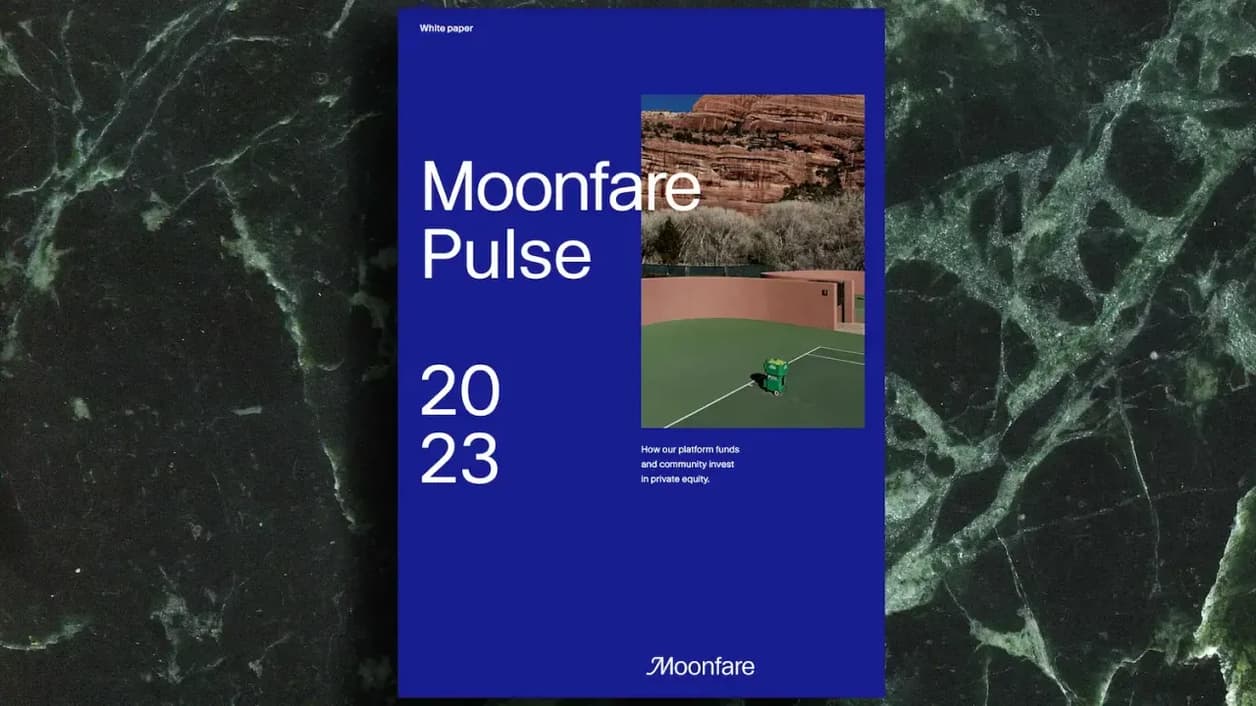
The last couple of years has seen a sea change in private markets. From an unprecedented bull run since 2008, fuelled by technological disruption and high levels of liquidity, many investors in the space are now facing generational challenges stemming from high interest rates, elevated inflation and smaller exit windows.
In this environment, the choices that general partners (GPs) and limited partners (LPs) make are magnified even further as their margin for error shrinks. So what is it that they are doing?
With this in mind, we’ve put together the Moonfare Pulse, our regular snapshot of deal activity from the top-tier fund managers on our platform, and commitment trends from our investor community.
Key highlights
- Long term, Moonfare investors prioritise buyouts. Although 2021 was a year of growth equity with its focus on technology, overall, buyouts remain the strategy of choice for most individual investors.
- Millennials newfound interest in private equity. The number of Moonfare investors younger than 35 has doubled in the last few years, a trend that is expected to continue.
- Buyout dealmaking shows resilience despite headwinds. In a tougher environment, overall private activity stalled. However, buyout funds on the Moonfare platform incrementally increased their initial investments each subsequent quarter last year.
- Technology investments dominate dealmaking. Once the provenance of venture and growth managers, technology investment now also makes up the majority of deals among buyout funds on the Moonfare platform.
Inside Moonfare feeder funds: How individuals invest in private equity
About the data
Moonfare feeder fund data offers insight into the preferences and investment decisions of individual allocators to private equity funds from top tier managers.
We analysed activity across 74 feeder funds that were available between January 1, 2020 and December 31, 2022. Through the Moonfare platform, more than 2660 eligible individual investors collectively invested around $2.1 billion. These investors had to meet certain criteria which may include a minimum financial instrument portfolio and sufficient prior investment experience. Investors were domiciled in Europe, the US and Asia.
Buyouts remain dominant
2021 was the year for growth equity, driven by an extraordinary appetite for high-growth technology businesses during the pandemic, coupled with abundant dry powder and ultra-low interest rates.
In 2021, these investments made up 65% of all allocations to Moonfare feeder funds, up from only 8% in 2020. Venture capital, which typically provides funding to early-stage businesses, accounted for an additional 7% of the entire tally in 2021.
The Series C of PandaDoc is an example of this hunt for businesses at the forefront of digital transformation that was unfolding for the most of 2021. Its e-documentation platform “played a big role” in the shift to entirely virtual processes during the pandemic, attracting extensive funding from growth equity funds such as Canada-based Omers.¹ In aggregate, growth equity deal value hit a record $121.5 billion in 2021, according to PitchBook data.²
However, as economic circumstances deteriorated over the course of 2022, investors turned their attention back again to more value-orientated strategies. Buyout funds, which are typically targeting mature companies with proven business models, have bounced back (in relative terms) to again account for more than half of all investments made through the Moonfare platform.
Pulse spotlight: The growing appetite for secondaries
Starting in late 2021 and more prominently in 2022, strategies with recession-resilient characteristics also found their way onto investors’ radars. Investors have been seeking shelter outside typical private equity strategies, venturing into secondaries, in particular. According to Moonfare data, 12% of all allocation value in 2022 was targeting secondary opportunities, compared to only 6% a year prior. This data also underscores sentiment captured in last year’s Moonfare’s Investor Survey in which 37% of respondents said secondaries are one of their top three considerations.
What is the potential appeal of the strategies? Secondaries provide investors with an option to exit their private market positions prematurely, giving them levers to better manage cash flow - a critical feature in downturns when capital calls often outpace distribution activity. Secondaries buyers, on the other hand, may capitalise on discounted prices and could benefit from the reduced risk of a blind pool as the investments underlying a fund are typically known and can be therefore better evaluated. Finally, fund managers are increasingly employing secondary vehicles to extend ownership of prized assets beyond the typical holding periods. This allows them to postpone selling portfolio companies when M&A markets are more muted.
Globally, secondaries had their second-biggest year ever in 2022, just behind the record volumes of 2021. Around $108 billion was raised last year, according to a report from the investment bank Jefferies.³ Given the overall appetite, secondaries may continue their ascend this year as bid-ask spreads narrow.
Millennial investors show growing interest in private equity
The share of investors in Moonfare feeder funds who are younger than 35 has been steadily increasing, underscoring the appeal of the asset class for emerging wealth holders. The number of allocations invested by people between 25 and 34 of age has doubled in 2022, compared to two years prior. Overall, at the end of 2022, investors who were younger than 35 made around 12% of all allocations (by number) through Moonfare.
This is in line with a broader trend; younger and more risk-tolerant investors are seeking to maximise long-term wealth by allocating to higher-returning but higher-risk assets. Indeed, a 2022 Bank of America study found that 75% of investors between the ages of 21 and 42 did not believe it was possible to secure above-average returns by investing only in stocks and bonds, with 80% of these young investors turning to alternative investments. They primarily seek the extra upside in private equity, cryptocurrencies and by directly investing in companies.⁴
Considered an entry ticket to private equity, millennial private investors also seem more interested in Moonfare portfolio solutions, compared to older and presumably more experienced investors. The appeal of these products for first-time private equity investors may lie in their diversification benefits, as well as lower minimums.
Bigger the financial portfolio, the bigger the appetite for risk
When analysing the correlation between the size of financial instruments and investment preferences, we found that Moonfare investors with larger means are more drawn to higher-reward, higher-risk investments, such as venture capital - compared to investors with more limited financial capacity. In contrast, these investors tend to favour traditional strategies, such as buyouts, or portfolio solutions.
For example, around 16% of individuals who reported having a financial portfolio worth more than $25 million are invested in venture capital funds. In contrast, only 6% of investors with assets valued below $500,000 are exposed to venture capital.
Strategy-specific preferences aside, alternatives and private equity in particular are clearly gaining momentum among high-net-worth (HNW). These investors own more than $1 million in investable assets.
Almost three-quarters have allocated at least 10% of their portfolios to alternatives in 2021, up from only 50% in 2018, according to a report from Connection Capital.
Private equity is the most sought-after asset, followed by special situations and distressed debt funds, later stage venture capital investments and private equity secondaries.⁵
Dealmaking snapshot: where top-tier fund managers are investing
Overall dealmaking activity stalled in 2022, as widely expected, given the sudden shift in environment. Funds on the Moonfare platform conducted 128 initial investments in Q3 2022 for a total of $19.2 billion. At their peak, in Q4 2021, platform funds made 358 initial investments for over $43 billion.
Buyouts show resilience in a tough year
Focusing on the major strategies of buyout, growth and venture, we see marked differences in behaviour. Initial investments from the platform’s venture funds stalled in the year, while growth fund activity fell markedly toward the end of 2022. The latter could be partially explained given the differences in valuations in the growth market versus other sectors.
However, the platform’s buyout GPs showed different characteristics. While they also fell from 2021’s historic highs in the first quarter, buyout funds incrementally increased their initial investments each subsequent quarter.
Private equity becomes a ‘tech-first’ asset class
The predominance of technology investing is well known in venture and growth, given many of the companies they are targeting are on the cutting edge of innovation. However, the last couple of years has shown that top tier fund managers looking for equity control are increasingly moving in a similar direction.
Information technology represented over half of the capital deployed for initial investments from buyout firms in the first three quarters of 2022, compared with less than a third in each of the previous two years.
The shift had already been noticeable with a number of blockbuster deals in 2021, including KKR’s multibillion-dollar acquisition of Cloudera. Yet while the capital outlay in 2022 is smaller in dollar terms, the increased concentration on technology suggests this has become an area of focus even for more established private equity investors.
Healthcare VC falls back following COVID bounce
While private markets investing retreated last year, it didn’t do so in a uniform fashion across industries.
Looking at VC in particular, we can see that the healthcare boom induced during COVID cooled off last year. In the first three quarters of 2022, capital deployed in the sector fell to just 20% of overall VC initial investments, compared with almost 30% in 2021.
Pulse spotlight: How a downturn could prove fertile ground for carve-outsCarve-outs
Navigating turbulent times can be tricky for many private markets investors, not only because of the environment but because of the multitude of options available to them. What strategies do they want to pursue?
Moonfare analysis indicates that buyout funds are eyeing carve-outs in the future. These deals are typically a subsection of corporate divestments, where a private equity investor will ‘carve out’ the business unit in question and help operate it as a standalone firm.
According to Preqin data, carve out deals fell considerably in 2022, with the 3,837 deals worth $641.8 billion representing decreases of 19% and 44% year respectively year-on-year. For top-tier private equity funds, however, this could change. Recessions can often prove a prime period for carve-out opportunities, as corporates look to shed non-core assets in a bid to shore up their balance sheets. Indeed, as Francisco Partners partner Justin Chen recently told PE Hub: “The current challenging macroeconomic environment, coupled with corporates that are focused on how they can improve shareholder value, will result in a lot more divestiture activity. We are having a lot of these conversations across the landscape.”



¹ https://techcrunch.com/2021/09/22/pandadoc-the-e-document-startup-now-valued-at-1b-as-it-closes-a-big-series-c/ ² https://pitchbook.com/news/articles/growth-equity-deal-activity-2021 ³ https://www.jefferies.com/CMSFiles/Jefferies.com/files/IBBlast/Jefferies-Global_Secondary_Market_Review-January_2023.pdf ⁴ https://ustrustaem.fs.ml.com/content/dam/ust/articles/pdf/2022-BofaA-Private-Bank-Study-of-Wealthy-Americans.pdf ⁵ https://www.privateequitywire.co.uk/2022/07/25/316303/connection-capital-survey-reveals-increase-hnwi-alternative-investment
